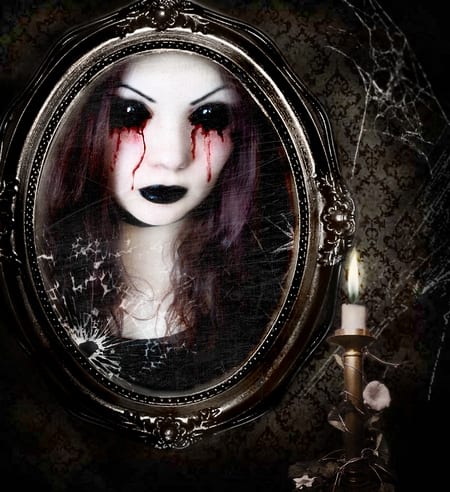Bloody Mary is more than a character. She’s a Halloween (or anytime) tradition amongst young people. You dare each other and egg your friends on until one of you is brave enough to hit the lights, stand in front of a mirror and chant “Bloody Mary” 13 times…
Then you wait for the inevitable: for the spirit of the Bloody Mary to appear out of nowhere, kill you and your friends, and ruin your sleepover!
Okay, the murder part doesn’t actually happen, but you know you thought it might when you were a kid (as did I). The ritual is so impactful that different versions of the legend exist across the globe — sometimes centered around a woman named Mary Worth, sometimes involving the devil himself appearing.
It turns out that seeing things in the mirror really isn’t that strange after all. The longer you stare in the mirror, the more likely you are to see stuff that isn’t really there. This phenomenon can be blamed, in part, on what’s known as the Troxler effect. If you stare at the same object for a long time, your brain gets used to the image and the unchanging stimuli. What happens next is pretty incredible: your neurons cancel the information out, and whatever you’re staring at can start to appear blurry or distorted. Until you blink and look around, you’ll continue to see these unusual visions.
What’s more, if you stare into your own eyes in a mirror long enough, your face will begin to change shape.
Here’s a test for you. Stare at the plus sign in the center of the image below for 8 seconds.
Your brain probably tricked you and distorted your vision in a number of ways, possibly by making the colors in the image fade to gray. Live Science points out that this is actually a coping mechanism. “If you couldn’t ignore the steady hum of your computer monitor, the constant smell of your own body odor or the nose jutting out in front of your face, you’d never be able to focus on the important things — like whether your boss is standing right behind you,” the article explains.
The “strange face in the mirror” phenomenon, like Bloody Mary, is part of this as well. A 2010 experiment conducted by an Italian psychologist had people stare into a mirror for 10 minutes. 66% of the subjects reported seeing “huge deformations” of their face, and 48 % saw “fantastical and monstrous beings.”
So maybe this is why so many people claim to have seen Bloody Mary in the mirror, and why the legend continues to frighten kids to this day. However, while origin of Bloody Mary is debated, but some believe it dates back to a real person — Queen Mary I from the 16th century, who was called Bloody Mary by her protestant enemies.
Others think the legend may be based on a different real person named Mary because varying legends give different versions of her name (Mary Worth, Mary Worthington, Mary Lou). Either way, one thing is for sure — kids will continue to play this spooky game forever, so let’s just hope Bloody Mary doesn’t get angry enough to come bursting through the mirror.
The post The Story Behind Bloody Mary and Why We Think We See Stuff in Mirrors appeared first on UberFacts.




